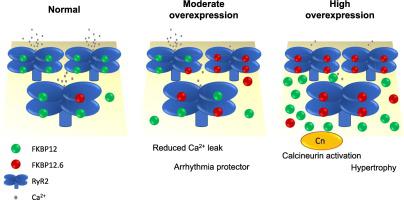当前位置:
X-MOL 学术
›
J. Mol. Cell. Cardiol.
›
论文详情
Our official English website, www.x-mol.net, welcomes your feedback! (Note: you will need to create a separate account there.)
Dual effect of cardiac FKBP12.6 overexpression on excitation-contraction coupling and the incidence of ventricular arrhythmia depending on its expression level
Journal of Molecular and Cellular Cardiology ( IF 5 ) Pub Date : 2024-01-14 , DOI: 10.1016/j.yjmcc.2024.01.003 Marine Gandon-Renard , Almudena Val-Blasco , Célia Oughlis , Pascale Gerbaud , Florence Lefebvre , Susana Gomez , Clément Journé , Delphine Courilleau , Françoise Mercier-Nomé , Laetitia Pereira , Jean-Pierre Benitah , Ana Maria Gómez , Jean-Jacques Mercadier
Journal of Molecular and Cellular Cardiology ( IF 5 ) Pub Date : 2024-01-14 , DOI: 10.1016/j.yjmcc.2024.01.003 Marine Gandon-Renard , Almudena Val-Blasco , Célia Oughlis , Pascale Gerbaud , Florence Lefebvre , Susana Gomez , Clément Journé , Delphine Courilleau , Françoise Mercier-Nomé , Laetitia Pereira , Jean-Pierre Benitah , Ana Maria Gómez , Jean-Jacques Mercadier

|
FKBP12.6, a binding protein to the immunosuppressant FK506, which also binds the ryanodine receptor (RyR2) in the heart, has been proposed to regulate RyR2 function and to have antiarrhythmic properties. However, the level of FKBP12.6 expression in normal hearts remains elusive and some controversies still persist regarding its effects, both in basal conditions and during β-adrenergic stimulation. We quantified FKBP12.6 in the left ventricles (LV) of WT (wild-type) mice and in two novel transgenic models expressing distinct levels of FKBP12.6, using a custom-made specific anti-FKBP12.6 antibody and a recombinant protein. FKBP12.6 level in WT LV was very low (0.16 ± 0.02 nmol/g of LV), indicating that <15% RyR2 monomers are bound to the protein. Mice with 14.1 ± 0.2 nmol of FKBP12.6 per g of LV (TG1) had mild cardiac hypertrophy and normal function and were protected against epinephrine/caffeine-evoked arrhythmias. The ventricular myocytes showed higher [Ca] transient amplitudes than WT myocytes and normal SR-Ca load, while fewer myocytes showed Ca sparks. TG1 cardiomyocytes responded to 50 nM Isoproterenol increasing these [Ca] parameters and producing RyR2-Ser2808 phosphorylation. Mice with more than twice the TG1 FKBP12.6 value (TG2) showed marked cardiac hypertrophy with calcineurin activation and more arrhythmias than WT mice during β-adrenergic stimulation, challenging the protective potential of high FKBP12.6. RyR2 CPVT mice overexpressing FKBP12.6 showed fewer proarrhythmic events and decreased incidence and duration of stress-induced bidirectional ventricular tachycardia. Our study, therefore, quantifies for the first time endogenous FKBP12.6 in the mouse heart, questioning its physiological relevance, at least at rest due its low level. By contrast, our work demonstrates that with caution FKBP12.6 remains an interesting target for the development of new antiarrhythmic therapies.
中文翻译:

心脏 FKBP12.6 过表达对兴奋-收缩耦合的双重影响以及取决于其表达水平的室性心律失常的发生率
FKBP12.6 是一种免疫抑制剂 FK506 的结合蛋白,也与心脏中的兰尼碱受体 (RyR2) 结合,已被提议调节 RyR2 功能并具有抗心律失常特性。然而,正常心脏中 FKBP12.6 的表达水平仍然难以捉摸,并且关于其在基础条件下和 β-肾上腺素能刺激期间的影响仍然存在一些争议。我们使用定制的特异性抗 FKBP12.6 抗体和重组蛋白,对 WT(野生型)小鼠的左心室 (LV) 和表达不同水平 FKBP12.6 的两种新型转基因模型中的 FKBP12.6 进行了定量。WT LV 中的 FKBP12.6 水平非常低(0.16 ± 0.02 nmol/g LV),表明 <15% 的 RyR2 单体与蛋白质结合。每克 LV (TG1) 含有 14.1 ± 0.2 nmol FKBP12.6 的小鼠具有轻度心脏肥大和正常功能,并且可以防止肾上腺素/咖啡因引起的心律失常。心室肌细胞表现出比 WT 肌细胞和正常 SR-Ca 负荷更高的 [Ca] 瞬态振幅,而较少的肌细胞表现出 Ca 火花。TG1 心肌细胞响应 50 nM 异丙肾上腺素,增加这些 [Ca] 参数并产生 RyR2-Ser2808 磷酸化。TG1 FKBP12.6 值 (TG2) 超过两倍的小鼠在 β-肾上腺素能刺激期间表现出明显的心脏肥大,伴有钙调神经磷酸酶激活,并且比 WT 小鼠出现更多心律失常,挑战了高 FKBP12.6 的保护潜力。过表达 FKBP12.6 的 RyR2 CPVT 小鼠表现出较少的致心律失常事件,并降低了应激诱导的双向室性心动过速的发生率和持续时间。因此,我们的研究首次量化了小鼠心脏中的内源性 FKBP12.6,质疑其生理相关性,至少在休息时由于其水平较低。相比之下,我们的工作谨慎地表明,FKBP12.6 仍然是开发新的抗心律失常疗法的一个有趣的靶点。
更新日期:2024-01-14
中文翻译:

心脏 FKBP12.6 过表达对兴奋-收缩耦合的双重影响以及取决于其表达水平的室性心律失常的发生率
FKBP12.6 是一种免疫抑制剂 FK506 的结合蛋白,也与心脏中的兰尼碱受体 (RyR2) 结合,已被提议调节 RyR2 功能并具有抗心律失常特性。然而,正常心脏中 FKBP12.6 的表达水平仍然难以捉摸,并且关于其在基础条件下和 β-肾上腺素能刺激期间的影响仍然存在一些争议。我们使用定制的特异性抗 FKBP12.6 抗体和重组蛋白,对 WT(野生型)小鼠的左心室 (LV) 和表达不同水平 FKBP12.6 的两种新型转基因模型中的 FKBP12.6 进行了定量。WT LV 中的 FKBP12.6 水平非常低(0.16 ± 0.02 nmol/g LV),表明 <15% 的 RyR2 单体与蛋白质结合。每克 LV (TG1) 含有 14.1 ± 0.2 nmol FKBP12.6 的小鼠具有轻度心脏肥大和正常功能,并且可以防止肾上腺素/咖啡因引起的心律失常。心室肌细胞表现出比 WT 肌细胞和正常 SR-Ca 负荷更高的 [Ca] 瞬态振幅,而较少的肌细胞表现出 Ca 火花。TG1 心肌细胞响应 50 nM 异丙肾上腺素,增加这些 [Ca] 参数并产生 RyR2-Ser2808 磷酸化。TG1 FKBP12.6 值 (TG2) 超过两倍的小鼠在 β-肾上腺素能刺激期间表现出明显的心脏肥大,伴有钙调神经磷酸酶激活,并且比 WT 小鼠出现更多心律失常,挑战了高 FKBP12.6 的保护潜力。过表达 FKBP12.6 的 RyR2 CPVT 小鼠表现出较少的致心律失常事件,并降低了应激诱导的双向室性心动过速的发生率和持续时间。因此,我们的研究首次量化了小鼠心脏中的内源性 FKBP12.6,质疑其生理相关性,至少在休息时由于其水平较低。相比之下,我们的工作谨慎地表明,FKBP12.6 仍然是开发新的抗心律失常疗法的一个有趣的靶点。



























 京公网安备 11010802027423号
京公网安备 11010802027423号